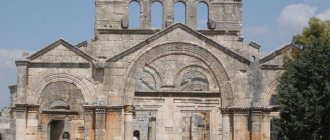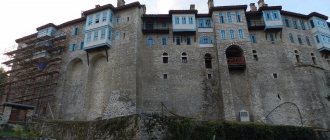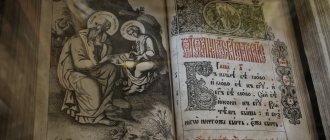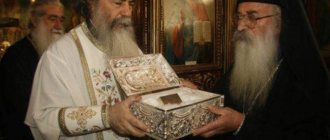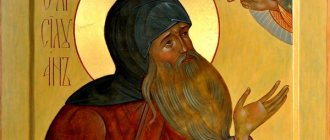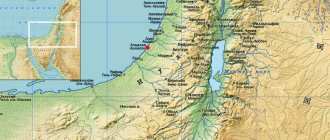| St. Simeon the New Theologian, Greek icon. |
Simeon the New Theologian
(946 - 1022), abbot, venerable Memory March 12 and October 12 (Greek [1])
Born in 946 in the city of Galata (Paphlagonia) and received a thorough secular education in Constantinople. His father prepared him for a court career, and for some time the young man occupied a high position at the imperial court. But having reached the age of 25, he felt an attraction to monastic life, fled from home and retired to the Studite monastery, where he underwent obedience under the guidance of the then famous elder Simeon the Reverent.
Studite Monastery
The main feat of the saint was the incessant Jesus Prayer in its short form: “Lord, have mercy!” For greater prayerful concentration, he constantly sought solitude, even during the liturgy he stood separately from the brethren, and often remained alone at night in church; To get used to remembering death, he spent nights in the cemetery. The fruit of his zeal was a special state of admiration: during these hours the Holy Spirit in the form of a luminous cloud descended on him and covered everything around him from his eyes. Over time, he achieved constant high spiritual enlightenment, which was especially evident when he served the Liturgy.
Monastery of St. Mamant
Around 980, the Monk Simeon was made abbot of the monastery of the holy martyr Mamant. He was ordained to the rank of presbyter by Patriarch Nicholas II of Constantinople.
St. Simeon put the neglected economy of the monastery in order and landscaped the temple in it.
The Monk Simeon combined kindness with severity and strict observance of the Gospel commandments. So, for example, when his favorite student Arseny killed the crows that had eaten soaked bread, the abbot forced him to string the dead birds on a rope, put this “necklace” around his neck and stand in the yard. In the monastery of St. Mamant, a certain bishop from Rome, who accidentally killed his young nephew, atone for the sin, and the Monk Simeon invariably showed kindness and attention to him.
The strict monastic discipline, which the monk constantly instilled, led to strong discontent among the monastic brethren. One day after the liturgy, particularly irritated brothers attacked him and almost killed him. When the Patriarch of Constantinople expelled them from the monastery and wanted to hand them over to the city authorities, the monk begged forgiveness for them and helped them in their lives in the world.
Around 1005, the Monk Simeon handed over the abbess to Arseny, and he himself settled at the monastery in retirement.
Exile and foundation of the monastery of St. Marina
The Monk Simeon annually celebrated the memory of his mentor Simeon the Reverent, composed words of praise, songs and canons in his honor, and painted his icon. Patriarch Sergius the Manuilite, having heard about this, approved of Simeon, but Metropolitan Stephen of Nicomedia, and with him some of the parish priests and laity, rebelled against this custom, finding it contrary to the order of the church and tempting [2].
To calm minds and satisfy Stephen, the Patriarch and the Synod decided to remove Simeon from Constantinople. He retired to the shores of the Bosphorus and to the area belonging to his student and admirer, the patrician Christopher Fagur. Here the Reverend established a monastery for St. Marina, lived in it for 13 years and died peacefully in 1022 [3].
During his lifetime he received the gift of miracles. Numerous miracles were performed even after his death; one of them is the miraculous acquisition of his image. His life was written by his cell attendant and disciple, the Monk Nikita Stifat.
| St. Simeon the New Theologian, icon |
Saint Simeon the New Theologian - monk, theologian, poet
Simeon the New Theologian is a monk, theologian, and writer of poetic spiritual verses called “Hymns.” He is one of the most prominent representatives of the tradition of hesychasm, that is, the Christian mystical worldview, an ancient spiritual practice that forms the basis of Orthodox asceticism.
For his wisdom, he received the name New Theologian, along with two other great theologians of the Christian Church - John the Theologian and Gregory the Theologian. He is revered by the Orthodox Church in the person of St.
Venerable Simeon the New Theologian. Icon. Reverend Simeon the New Theologian is a monk, theologian, and writer of poetic spiritual verses
Saint Simeon was born in 946 into a wealthy family of provincial nobles in the city of Galatea, Paphlogia (Asia Minor). His parents wanted to give him a good education and at the age of eleven they sent him to study in Constantinople.
The saint's father wanted to send him, upon completion of his studies, to the imperial state service.
946
Saint Simeon the New Theologian was born this year
Despite his father's wishes, Simeon did not at all want to become a brilliant courtier. From childhood he sought to serve God. Fulfilling his desire at the age of 25, he ran away from home without even receiving a secondary education.
He escaped together with an elderly monk from the Studite monastery. His name was also Simeon.
Venerable Simeon the New Theologian, Greek icon. It is believed that Saint Simeon initially lost interest in monastic life after he saw the Divine Light in a vision
The saint had a vision during night prayer. It is believed that Divine light appeared to him. After this appearance Simeon grew cold and decided to return to worldly life. For several years he lived like this, avoiding sinful actions and deeds through the prayers of the elder.
At the same time, he kept thinking about how to move away from the world, despite his spiritual cooling.
Prayer to St. Simeon the New Theologian
Creation of the Venerable Nicodemus the Holy Mountain
O God-bearing and Christ-bearing and spirit-bearing Father Simeon, New Theologian, praise to the saints, glory to the priests, delight to the theologians, intelligent prayers to the teacher, glorifying God and from God glorified in your life, especially after death, earthly angel and heavenly man, spiritual and spiritual joy Joy to us, your humble servant and your unworthy son, who celebrate your sacred and luminous memory with reverence and love! Accept this song, even as we offer you as an insignificant and smallest gift, for the great gifts of grace, which we will enjoy in all things, I received from you, from the book of your sacred words, and did not answer live this life, as I am unworthy of your splendor: for we are weak, but it is worthy Praise you, such a great theologian. And in this life, preserve us with your prayers from all harm, mental and physical, visible and invisible enemies, constantly praying to God in the Trinity, may He grant us, the humble, to mysteriously feel the power In the midst of our hearts, the intelligence of the divine grace of the Holy Spirit has already been destroyed, Alas! our negligence and passions; in the future, through your strong intercessions, deliver us from terrible condemnation and eternal torment, and grant us eternal bliss in Christ Jesus, our Lord, to whom all things are due. glory, honor and worship, with His beginningless Father and His Most Holy and Life-giving Spirit, now and forever and ever. Amen.
* Although St. Simeon the New Theologian died on March 12, 1022 (27), however, due to the fall of the saint’s memory during Lent, the Church moved the celebration of the memory to October 12.
Saint Simeon the New Theologian is considered a Christian mystic
Due to the fact that the Monk Simeon the New Theologian always adhered to the ideas about the possibility and necessity of feeling the presence of God even at the early stages of asceticism, he is considered a Christian mystic.
Naturally, the understanding of this term is oral. Believing that Christ gives grace to all those who seek the path of unity with Him, the saint tried to convey his experience of meeting with Him not only to the brethren, but also to the widest possible circle of people.
1005
this year Saint Simeon transferred the abbess to Arseny after the indignation of the monks of the Studio monastery
The abbot gained great popularity and people from different places began to come to him. At the same time, he introduced strict monastic discipline into the monastery. After 15 years had passed since his appearance in the monastery, some of the monks, dissatisfied with the strict regulations of the abbot, staged an indignation.
One day, during the liturgy, the instigators of the riot rushed at the abbot. The life of the saint says that the grace of God that dwelt in him as a saint helped him to hold back and throw away the wicked.
Saint Simeon the New Theologian. Icon. In all the monasteries where the Monk Simeon resided as abbot, he introduced strict rules
Troublemakers ran out of the church and broke down the doors of the monastery. After that they ran to the Patriarchate. Having told the Patriarch of Constantinople Sisinnius their complaints, they began to ask him for support.
The Patriarch, having understood their essence, ordered them to be expelled from the monastery and wanted to hand them over to the city authorities. Saint Simeon begged forgiveness for them from him and later helped them in their worldly life. Around 1005, the Monk Simeon handed over the abbess to Arseny, and he himself settled at the monastery in retirement.
Prayers
Troparion, tone 3
Divine illumination, Father Simeon, / having received in your soul, / you have appeared as the brightest luminary in the world, / dispelling that obscurantism / and assuring everyone to seek, even after destroying, the grace of the Spirit, / diligently pray for Him // to grant us great mercy
.
Troparion, tone 1
You were not involved in external wisdom, / but you were filled with the Divine, / and the New Theologian was truly known by everyone, Simeon. / For this sake of your memory, wise father, we cry out to you: / glory to Christ who glorified you, / glory to Him who showed you wondrously, // glory to Him who heals you all
.
Troparion, tone 4
As a spectator of the Trisolar Light / and a teller of the mysterious Theology, / blessed Simeon, our Father, / ask for enlightenment for our souls from above / and drive away the darkness of passions from us, / for, as a great servant of Christ, // you give useful things to everyone, reverend
.
Kontakion, tone 3
Enlightened by the Trisolar Light, O God-Wise One, / Thou art the Theologian of the Divine Trinity. / Having been enriched from above with the wisdom of words, / you have exuded Divine streams of God-wisdom, / drinking from them, we cry: // Rejoice, blessed Simeon, taught by God
.
In Kontakion, voice 2
(Similar to: Thy blood)
As the Most Divine Theologian of God / and our great prayer book to the Lord, / everlastingly, Simeon, pray to grant us forgiveness of sins // and correction of life, reverend
.
Before his death, the Monk Simeon the New Theologian founded a new monastery
The Monk Simeon the New Theologian experienced feelings of strong affection for his spiritual father Simeon the Reverent. That is why he annually celebrated his memory, wrote words of praise, songs and canons in his honor, as well as his icon.
Patriarch Sergius Manulit approved the saint’s act, but Metropolitan Stephen of Nicomedia and some of the parish priests and laity rebelled against such a custom. They found it contrary to church order and also seductive.
Residence of the Patriarchs of Constantinople in Constantinople (Istanbul). Engraving. 1737. In 1009, Patriarch Sergius Manulitus of Constantinople decided to remove St. Simeon the New Theologian from Constantinople.
In order to calm the minds of the brethren and satisfy Stephen, the Patriarch, together with the Synod, decided to remove Simeon from Constantinople. This happened before the beginning of 1009.
The saint retired to the banks of the Bosophorus, to the area that belonged to his disciple and admirer, the patrician by birth, Christopher Fagur. Here the Patriarch transferred to the management of Saint Simeon the prayer house of Saint Mary, on the basis of which he later created the monastery of Saint Mary.
The Monk Simeon the New Theologian lived in the monastery of St. Mary for 13 years. Here he wrote most of his Hymns. In 1022, he died peacefully in the monastery from a stomach illness.
Even during the life of the saint, it became known that he received from God the gift of miracles. For example, after his death, an icon of the saint was miraculously found. In Orthodoxy, the saint is commemorated on March 12 (25).
Monastic life
Finally, with the assistance of God, Simeon made the final decision to renounce the vain secular life and join the ranks of the monastic brotherhood.
Having entered the Studii monastery, he met here his spiritual father, long-time mentor, Simeon the Reverent. Having genuine, sincere respect for him, Simeon jealously fulfilled all his demands. Meanwhile, many monks reacted ambiguously to Simeon’s strong affection (to his spiritual father). It seemed to them that such affection was too excessive, that his obedience to his spiritual father contradicted the general rule of submission to the abbot.
Simeon, sincerely believing that God had given him a confessor, did not want to weaken his obedience, and as a result of the displeasure of the brethren he was forced to leave the monastery.
His new refuge was the small monastery of St. Mamant, also called the Xerokerk monastery. At the same time, he continued to remain in obedience to Simeon the Reverent (who continued to asceticize in the Studite monastery).
In the new monastery, Simeon soon took monastic vows. The saint's sincere faith, zeal and virtue did not go unnoticed by the brethren and the authorities of the monastery, and soon Simeon was awarded the elevation to priestly dignity, and three years later he was elevated to the rank of hegumen. Simeon was then thirty-one years old.
“Words” and “Hymns” are the most famous works of St. Simeon the New Theologian
In theology, St. Simeon the New Theologian is known primarily as a theologian and preacher, and a distinctive feature of his theology is the application of theoretical Christian teaching to Christian life.
Unfortunately, the saint's works have been published in Slavic and Russian in very limited quantities. So, for example, in the “Philokalia” (a book of Orthodox spiritual writings printed: “Active and theological chapters” (numbering 152; in the Russian translation published in “Christian Reading”, 1823, under the title “One hundred and fifty-two active and theological chapters”), “A Word about Faith” (Russian translation in “Christian Reading”, 1821) and “A Word about Three Types of Prayer.”
Book. "Words of Simeon the New Theologian." Translated by Bishop Feofan. 1890 In his works the monk tried to apply theoretical theology to practice
In 1852, 12 “Words” of Simeon the New Theologian, taken from the number 35, were published in Moscow in a Slavic translation; These 12 “Words” were translated into Russian after careful comparison with the Greek manuscript located in the Moscow Synodal Library.
Other works of the Monk Simeon (ninety-two “words”, “Active and theological chapters” and “The ascetic word of Elder Simeon the Reverent” were translated from modern Greek by Bishop Theophan.
Saint Simeon the New Theologian is considered the founder of the doctrine of heavenly illumination of the soul.
All the works of the Monk Simeon are distinguished by their simplicity and sincerity. That is why they made a huge impression on their contemporaries. At the same time, at one time he was criticized a lot for precisely this simplicity.
The fact is that in Byzantium they were always guided by the rhetorical art of Ancient Greece, the canons of which the works of the saint did not correspond to.
Transfiguration of the Lord (icon Andrei Rublev, 1405). The teaching of Saint Simeon the New Theologian led to the dispute about the Light of Tabor (the dispute between the Palamites and the Vralaamites)
The Orthodox Church called St. Simeon the New Theologian because in his works there are similarities with the works of Gregory the Theologian. For example, they are characterized by a depth of contemplation of the truths of Christian piety.
Saint Simeon himself is considered the founder of the doctrine of heavenly illumination of the soul. It later led to the Palamite-Barlaamite dispute. It is worth noting that the Venerable Simeon the New Theologian was highly revered by the Venerable Nile of Sora, who often referred to him in his writings.
Hesyachism is silent prayer, its essence is expressed in the hymns of St. Simeon the New Theologian
Saint Simeon is often called the forerunner of hesychasm. This is a special mystical practice that originated in the 14th century. It is aimed at contemplating divine energies. Saint Gregory Palma, who laid out the foundations of this teaching, often refers to the works of Saint Simeon.
By the way, Nil Sorsky is considered a Russian successor of the traditions of Hesyachism precisely because in his writings he often uses excerpts from his works.
Saint Gregory Palamas Master of Northern Greece (Thessaloniki?) of the early 15th century. Saint Gregory, the founder of Hesyachism, often referred to the works of St. Simeon the New Theologian
The essence of hesychasm is very difficult to define, because even this concept itself comes from the Greek hesychasm, that is, “silence.” A monk immersed in contemplation does not preach sermons or utter theological formulations. His goal is to strive for inner, heartfelt contemplation of the Kingdom of God.
Hesyachism originated in the 14th century and St. Simeon is recognized as one of its founders.
Full-fledged “smart work,” as this type of prayer is sometimes called, is available only to monks, free from worldly vanity. By the way, the brethren of those monasteries in which Saint Simeon stayed were initially skeptical about his mystical practices.
Many did not believe the visions that the saint saw during “smart work,” which is why initially his nickname “New Theologian” was ironic.
Video: The hymns of St. Simeon the New Theologian are read by Metropolitan Hilarion (Alfeev). In the film, the author reads the hymns of St. Simeon.
In his hymns, the monk showed in poetic form the essence of “smart prayer.” Here is an example of one such essay:
Whoever wants to see this non-evening light must always guard his heart from passionate movements, from bad thoughts, from anger, embarrassment, and hypocritical oaths. He must be attentive to himself and not remember malice, not judge people even in the thoughts of his heart, be internally pure, frank in words, be sincere, meek, calm, humble. Let his meal not be rich, let him keep prayer and fasting unremittingly. And all his feats, and every deed, And every word - let it be with love.
(Translation by Metropolitan Hilarion Alfeev)
By leaving a comment, you accept the user agreement
